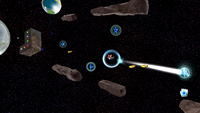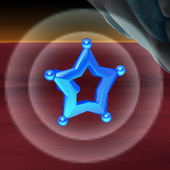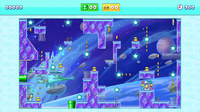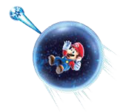Pull Star: Difference between revisions
| Line 45: | Line 45: | ||
SMG2 Space Storm Starting Planets.png|Pull Star Planets in Space Storm Galaxy | SMG2 Space Storm Starting Planets.png|Pull Star Planets in Space Storm Galaxy | ||
SMG2 Grandmaster Pull Star Area.png|Pull Star Area in [[Grandmaster Galaxy]] | SMG2 Grandmaster Pull Star Area.png|Pull Star Area in [[Grandmaster Galaxy]] | ||
Play Nintendo MMFaC Items Gravity Well.png|A Gravity Well pulling [[Mini Mario (toy)|Mini Mario]] in ''Mini Mario & Friends: amiibo Challenge'' | |||
</gallery> | </gallery> | ||
Revision as of 13:00, April 6, 2020
The Pull Star is an object that appears in Super Mario Galaxy and Super Mario Galaxy 2. It resembles a small, blue version of a Launch Star inside a blue bubble or orb. When activated, they pull Mario or Luigi towards them.
History
Super Mario series
Super Mario Galaxy

Pull Stars can be found in virtually every galaxy. When the player touches one with the Star Cursor, it uses a blue gravitational aura to lift Mario or Luigi off the ground, pulling him up toward it. Combining the power of these Pull Stars and using them in tandem can help them reach far heights or areas.
In some areas, Pull Stars are found orbiting other objects in the galaxy, such as Launch Stars or Power Stars. The player must use the right one at the right time to touch the object without accidentally "slingshooting" past it. In areas such as the Good Egg Galaxy and the Terrace, it is shown that blue Lumas actually transform into Pull Stars, in much the same way as yellow Lumas mostly transform into Launch Stars or Sling Stars.
As with Launch Stars, Pull Stars occasionally need to be assembled by gathering Star Chips. Five blue Star Chips are needed to make a Pull Star or set of Pull Stars appear.
A single Pull Star appears in every Dome onboard the Comet Observatory, where they allow the player to view the galaxies that are accessible from that particular Dome. When they select a galaxy to fly to, the Pull Star transforms into a Launch Star, which then shoots Mario or Luigi to that galaxy.
Blue Star Capsule Planets are round glass planets that have a Pull Star in their center. There are three such planets in Space Junk Galaxy and two in Ghostly Galaxy. If Mario gets pulled and held by these planets, he cannot be stationary unlike normal Pull Stars due to the shape of the planet; instead, he continuously bounces on their surface as he is getting pulled.
Super Mario Galaxy 2
Pull Stars return as common objects in Super Mario Galaxy 2, with the same role. Unlike in the previous game, none of them are formed from blue Lumas or Star Chips.
Mini Mario & Friends: amiibo Challenge
Pull Stars appear again in Mini Mario & Friends: amiibo Challenge, where they are referred to as Gravity Wells[1]. They are present in all levels of Gravity Galaxy and the fourth level of the Star World. By tapping them on the GamePad, they release a gravitational field that can pull a Mini towards the center, immobilizing the Mini. The toy will be released once the player taps the Pull Star again. They can be used to keep the Mini safe from a long fall or pull it from behind a wall.
Gallery
The Pull Star in the Terrace
Pull Stars in Sling Pod Galaxy
Blue Star Capsule Planets in Ghostly Galaxy
A Pull Star in Bowser's Lava Lair
Pull Stars in Space Storm Galaxy
Pull Star Area in Grandmaster Galaxy
A Gravity Well pulling Mini Mario in Mini Mario & Friends: amiibo Challenge
Names in other languages
| Language | Name | Meaning | Notes |
|---|---|---|---|
| Japanese | スターキャプチャー[?] Sutākyapuchyā |
Star Capture | |
| Chinese | 牵引星[?] Qiānyǐn Xīng |
Traction Star | |
| German | Greifstern[?] | Pull Star | |
| Italian | Stella Manina[?] | Small Hand Star | |
| Korean | 스타중계소[2] Seuta Junggyeso |
Star Relay Center | |
| Spanish (NOE) | Estrella imán[?] | Magnet star |
References
- ^ "You can use the Gravity Well to guide your Mini through walls and floors. Tap on the blue star to put your Mini in bubble, then you can pull your Mini along. Tap the bubble to pop it and release your Mini."—Mini Mario & Friends: amiibo Challenge Items. Play Nintendo. Retrieved April 6, 2020.
- ^ Super Mario Wii: Galaxy Adventure instruction manual (Korean version). Page 20.











